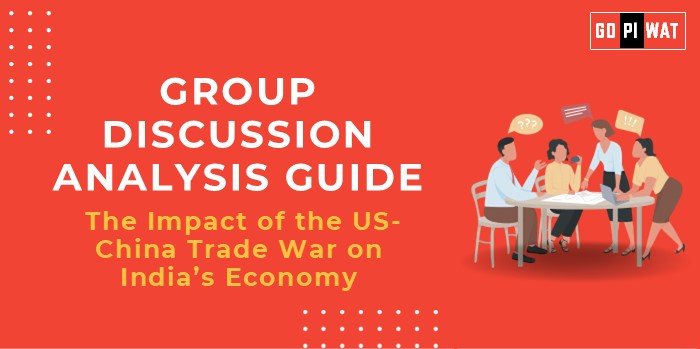📋 Group Discussion Analysis Guide
🌍 Topic: The Impact of the US-China Trade War on India’s Economy
🌟 Introduction
Opening Context: “The prolonged trade tensions between the US and China have reshaped the global economic landscape, presenting significant implications for developing economies like India. Understanding how India can adapt and thrive in this evolving scenario is crucial for B-school aspirants.”
Topic Background: Initiated in 2018 with tariffs on a wide range of goods, the US-China trade war has disrupted supply chains, forcing global businesses to reconsider their strategies. For India, this situation presents both opportunities to attract investment and challenges to overcome.
📊 Quick Facts & Key Statistics
- India-US Trade Volume (2023): $128.55 billion, a 7.65% increase from the previous fiscal year.
- China’s Exports to the US (2023): $124.52 billion in electronics and $88.98 billion in machinery.
- India’s FDI Inflows (2023): $1,033.40 billion since April 2000.
- Electronics Imports from China (2023): $44.15 billion, reflecting critical dependency.
- PLI Scheme Allocation: ₹1.97 lakh crore across 14 sectors, with the potential to generate 60 lakh jobs.
🔍 Stakeholders and Their Roles
- Indian Government: Drives policy initiatives like the PLI scheme to boost manufacturing and reduce import dependence.
- Private Sector: Diversifies supply chains and invests in domestic capabilities.
- Global Investors: Attracted by India’s reform-oriented policies and growth potential.
- International Organizations: WTO mediates tariff disputes and ensures compliance with trade norms.
📈 Achievements and Challenges
Achievements
- Rising Trade with the US: $128.55 billion bilateral trade in 2023, showcasing economic cooperation.
- FDI Boom: Over $1 trillion in cumulative inflows since April 2000, benefiting electronics and pharmaceuticals.
- PLI Scheme: Promoted domestic manufacturing and job creation in key sectors.
- Export Growth: Success in IT, automotive components, and textiles.
Challenges
- Dependence on Chinese Imports: $44.15 billion in electronics imports highlights vulnerabilities.
- Infrastructure Constraints: High logistics costs and limited port capacity hinder competitiveness.
- Skilled Labor Gap: Insufficient expertise in advanced manufacturing processes.
- Geopolitical Risks: Aligning with the US may strain India-China relations.
🌍 Global Comparisons
- Vietnam: Became a manufacturing hub for electronics through trade war opportunities.
- Mexico: Leveraged nearshoring advantages due to its proximity to the US.
Case Study: India’s smartphone manufacturing expansion, fueled by PLI incentives, positioned the country as a significant player in the global market.
💡 Effective Discussion Approaches
Opening Approaches
- “India-US trade increased by 7.65% in 2023, reflecting strengthening bilateral ties amidst the global trade realignment.”
- “While India’s FDI inflow crosses $1 trillion, its $44.15 billion dependency on Chinese electronics underscores the need for balanced growth.”
Counter-Argument Handling
- Use Vietnam’s success as an example to suggest actionable improvements.
- Highlight government reforms like the PLI scheme to address structural challenges.
🛠️ Strategic Analysis of Strengths & Weaknesses
- Strengths: Strategic geographic location, government support for manufacturing.
- Weaknesses: High dependency on Chinese imports, inadequate infrastructure.
- Opportunities: Trade diversification and potential leadership in IT and pharmaceuticals.
- Threats: Competition from Vietnam and Mexico, geopolitical tensions.
📚 Structured Arguments for Discussion
- Supporting Stance: “The US-China trade war has created opportunities for India to attract FDI and strengthen its manufacturing base.”
- Opposing Stance: “India’s infrastructure and dependency challenges prevent it from fully capitalizing on the trade war’s opportunities.”
- Balanced Perspective: “While the trade war offers a chance to grow, sustained reforms and investment in infrastructure are crucial for India’s success.”
🎓 Connecting with B-School Applications
Real-World Applications
- Analyze trade policy impacts on supply chains for operations management.
- Explore case studies on India’s PLI scheme for finance and strategy projects.
Sample Interview Questions
- “How can India reduce its dependency on Chinese imports while capitalizing on the US-China trade war?”
- “What role does the PLI scheme play in India’s economic strategy?”
Insights for Students
- Learn from Vietnam’s model to frame business strategies.
- Understand the role of trade policies in shaping global supply chains.


